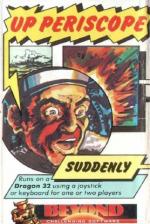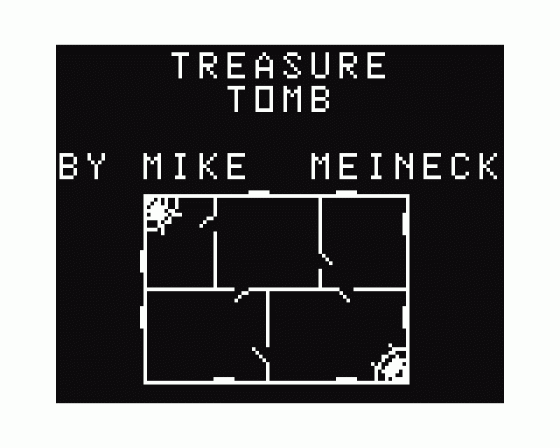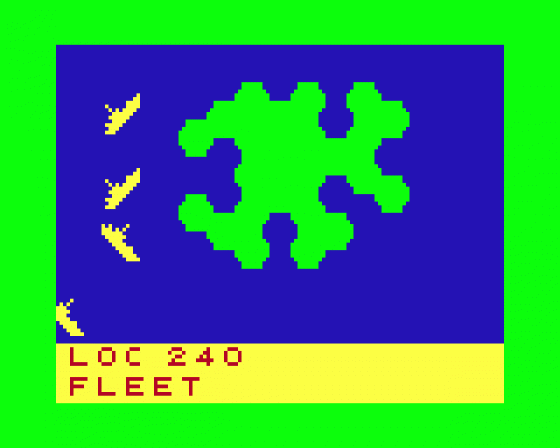
Dragon User
 1st March 1984
1st March 1984
Categories: Review: Software
Author: John Scriven
Publisher: Beyond
Machine: Dragon 32
Published in Dragon User #011
Introduction
In Greek mythology, there is the story of one Sisyphus, who was condemned to push a stone up a steep hill. When he reached the top, it would roll down the slope until it rested once more at the bottom. At this point, the luckless Sisyphus had to begin his task all over again. This story came to mind several times while looking at the software this month. I thought of it as I waited for the umpteenth cassette to load, and again as I battled with the next band of aliens that came my way. In my more jaundiced moments I felt glad that I hadn't paid out my hard-earned savings to see the game in question.
If there has been a recent trend in home computer programs, it seems to be that the software matches up even less to the steadily more imaginative (and imaginary) artwork on the packaging that it arrives in. Before you think that I am still suffering from an excess of Christmas pud, rest assured dear reader. The truly bad programs aren't even mentioned this month, and hiding in the pile are some that are models for the rest to follow.
Whirlybird Run (Dragon Data)
First, the arcade action games. Whirlybird Run, from Dragon Data, involves piloting a helicopter over mountainous terrain, while destroying enemy rockets and bases with guns and bombs. As the game progresses, you enter a cavern that scrolls across the screen as you meet more dangerous opponents while avoiding running out of fuel. If this sounds familiar to you, it should do, as this is simply a rather good version of the arcade favourite Scramble. The number of machines left, and the amount of fuel remaining, are shown at the top of the screen. One point always strikes me about this game - I can never grasp the logic that fills up your fuel tanks each time you bomb a fuel dump on the ground! In spite of this, and the fact that you seem to have a limitless supply of ammunition, the game is fun to play.
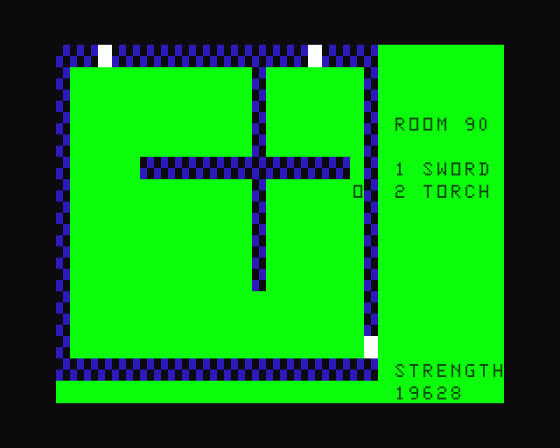
A more serious criticism is that it is priced at £12.95, which is rather excessive. Perhaps in an attempt to justify this price, Dragon Data has produced the worst example of over-packaging I have yet seen. The single cassette is contained in a full-sized video-cassette box, more than nine inches by seven inches in size, and over one and a half inches thick. The instruction booklet is A5 in size, yet the text could be fitted on one page. Firms like J. Morrison Micros, Premier and Salamander use a mini cassette case which is fine, but Dragon Data has made a mistake in using packaging that is so wasteful.
Strategic Command (Romik)
Romik has been producing Dragon software almost since the birth of the machine, and its game, Strategic Command, is a good example of using the computer as a display area for decisions made by two human players. Their recent titles show a move towards more machine-intelligent games. Convoy Attack is written by the same author, and consists of two parts. Part one entails guarding a convoy that appears as small blips at the bottom of the screen. Enemy missiles fly steadily towards your convoy, and can be destroyed by launching three planes from your aircraft-carrier and steering them into the path of the missiles. If your carrier is still intact at the end ot the first wave, the screen shows in high-resolution a dogfight between you and the enemy. Romik sets a good example by putting an actual screeshot of each program on the cover of its cassettes, and you are not tempted by false promises.
White Crystal (Romik)
Romik also produces a real-time graphics adventure game called White Crystal. This consists of a complex cave system - you enter at the bottom - linked by a series of ladders. In the cave are chests of gold, food and the white crystal itself, which must be struck by your sword. You control a small figure using the cursor control keys, and the program shows that games do not always have to be written in machine code to be worthwhile. One small niggle is that the program does not disable the other keys, and BREAK is rather close to the controls for comfort.
Treasure Tombe (Dungeon Software)
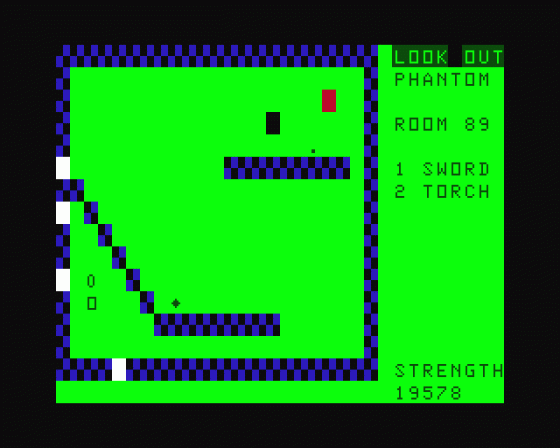
Another graphic adventure game written in Basic is Treasure Tombe from Dungeon Software. Apparently, there is a vast dungeon complex beneath Glastonbury Tor, containing Arthur's treasure. Set in Norman times, you can explore the labyrinth discovering the hidden wealth, while avoiding Merlin and his evil servants. Although this is not in the same league as fast-moving machine code games and only uses the lowest resolution display mode with symbols to represent the objects, the game is entertaining and interesting to play.
Giant's Castle (Dungeon)
Another adventure-type program from in the middle of a race Dungeon Software is Giant's Castle, a program designed for younger users. The object is to rescue a fair damsel from the giant's castle. In order to achieve this end, you must gain points by answering general knowledge questions. As the program is written in Basic, these are easy to change according to your requirements. The program uses a variety of tunes and drawings to enliven the proceedings but possesses some irritating features. The worst one is that occasionally you may be presented with a set of boxes. Choose the incorrect one and the program does not simply deposit you at the start again, it NEWs itself and you have to reload the program if you wish to play again. Hardly the best thing in a program designed for children.
Crusader (J. Morrison Micros)
J. Morrison Micros has an original game in Crusader, another graphic adventure game that employs good use of graphics. Using the joystick, you control an intrepid knight as he charges up flights of stairs and along castle walls that scroll along behind him. Littering his path are scorpions, enchanied lakes and mysterious dwarves. Each life you lose speeds upwards to heaven. Having jumped over the scorpions and swung across chasms, the sleeve notes assure me that I shall reach the inner sanctum and that the Holy Grail will be within my grasp. I have to take their word for it, as I have yet to get past the dwarves. This game is to be highly commended, and is similar in concept to Cuthbert In The Jungle.
Maurice Minor (J. Morrison Micros)
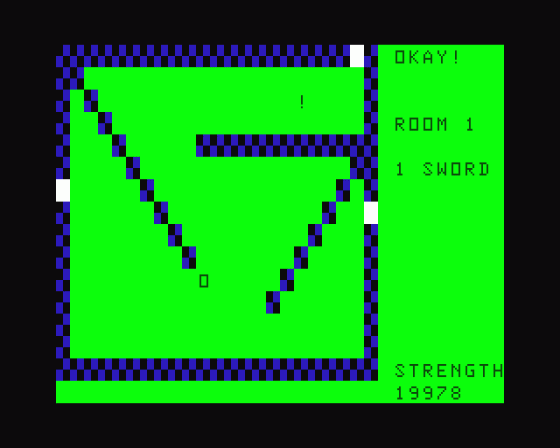
Having once seen the amazing graphics on the Atari motor-racing games, those written for other micros tend to come off second best. The displays are not up to showing the view from the driver's position, and usually rely on the screen scrolling downwards or to the left. Maurice Minor, also from J. Morrison Micros, uses the latter method. The story is that one day, while out for a quiet drive in your car, it strays on to a Grand Prix motor-racing circuit in the middle of a race. The joystick changes your direction, but you are constantly wandering to the left or right, and oil patches appear under your wheels. This would be difficult enough if you were on your own on the track, but cars are constantly rushing past you unless you can accelerate using the fire button and stay out of trouble. You can enter your level of driving expertise at the start (Grannie is a good level at which to begin), and the road is yours. If you collide with the barrier or another car, a bit falls off your "Maurice Minor". The object is to complete 10 miles in the shortest time while still retaining enough of your car to get you round. Again, this is hardly reaching the frontiers of arcade action, but it's good as Dragon car race games go.
Cyclops (Romik)
Cyclops from Romik is loosely based on Pac-man, in that it involves chasing round a maze eating energy nodules. It differs in that you can choose many different combinations of conditions, such as how many cyclops are after you, whether they are intelligent or not and how fast they move. Hidden in the maze are black holes that can send you spinning into another maze, more complex than the one you're in. If you don't have a version of Pac-man, this game can be recommended as it gives so many varieties and is less likely to become boring.
Uxb (Virgin Games)
Uxb was the wartime expression for an unexploded bomb, and Virgin has used it as the title of one of its programs. The aim is to defuse the bomb of the title, using only six items from a special toolkit. The program is menu-driven, and you can choose to view different sections of the bomb, or to attempt to defuse it. Although original in concept, there seemed to be only one correct path, and it was irritating being constantly blown into little pieces. I also managed to crash the program twice unintentionally. The inputs are not mug-trapped, and this spoils an attempt to produce an original game.
Death Mines Of Sirus (Phoenix)

A game that attempts to bridge the divide between arcade and adventure programs is Death Mines Of Sirus from Phoenix Sollware. The packaging is fairly large, but does contain two cassettes and instructions. As the program started and I entered Y for more instructions, I had to check the loudspeaker on my TV - the quality of the music was the best I had heard from my Dragon. Then I realised that the speaker was reproducing recorded music on the tape. Strains of Zarathustra filled the air, as a voice toid me of the rescue mission I had to lead. If you can cope with the rather pretentious beginning, the first cassette contains a lunar landing type game in which you have to pilot a drone to the surface of Sirus and pick up some miners waiting there. As you complete this stage, you are given a code to use in the second part of the adventure. I am led to believe that this consists of a text-only adventure, but as I failed to be given the necessary code in the arcade section, I could not start this part (hangs head in shame!). If you are not too good at arcade action, you could end up very irritated with this game. If this should happen, invite a friend with lightning fingers round and discover the code this way.
A supplier that appears new to me is Temptation Software. The two programs I have seen this month, one game-utility, and the other a version of a board game, are both packaged in an eye-catching box covered in "laser-cut" circles.
Searchword (Temptation)
The utility, Searchword, is a game that can be played on the screen, or can be used to generate word-squares and print them on to paper. As it is menu-driven, the program is very simple to use. Words of up to 12 letters in length can be entered, and the program inserts them into a rectangle in one of eight compass directions. Words may be saved on cassette and entered at a later stage or the whole word square may be copied to paper, if you have a printer attached. As a game, this program is quite good, but it really scores in educational areas. A set of spelling words, or those to do with a particular topic, could be entered by a parent or teacher, and the print-outs given to children to complete.
Micropoly (Temptation Software)

Micropoly from Temptation Software is a computer version of a certain well-known board trading-game known in some circles as "Go to Jail". Up to four players may participate. Some versions of this game mereiy use the screen as a display board, but Micropoly has the Dragon to play against you. All the options of the real game are present, including Chance and Community Chest. The displays are adequate, given the large playing surface of the board game, and the program is quite well written. If there are several of you, it's probably more fun to use the real game, but those closet capitalists out there may find this a way to trample on the poor in secret!
Up Periscope (Beyond)
Another new name in the lists of software houses is that of Beyond. Its game, Up Periscope, is neatly packaged, containing cartoon graphics as well as an actual screen shot of the game in progress. This is unfortunately on the inside of the sleeve notes, so you won't be able to see it before you purchase it, but it's a step in the right direction.
The game itself can be played against the computer or against another human, and involves moving a convoy of merchant vessels across an area of sea. There is a large island in the middle of the sea, which contains hunter-killer submarines as well as a convoy protection fleet.

You can command either the protection fleet or the submarines in the two-player option, but you're limited to fleet commander if you play against the computer. There are two displays; the playing area, showing your vessels, but not those of your opponent; and a status report informing you of the state of play. You can never see all the sea at one time, so the cursor keys or the joystick are used to move the viewing screen over different sections. Each part of the screen is hexagonal in shape, so travel is limited to one of six directions.
Movement is achieved by centring a cursor over options shown on the bottom of the screen. These include straightforward moves, depth-charges, torpedoes and sonar. The instructions are clear, and the game easy to play. While not possessing the speed or graphics of some arcade games, it is a well-thought-out game of strategy that should while away those long winter evenings. (If you play against the computer, then it undoubtedly cheats by peeking at your position, but luckily, there is an option so you can do the same!)
Empire (Shards Software)
Having blown away an ocean full of submarines, the megalomaniacs out there among you could do worse than move on to Empire from Shards Software.

At the start of the game, the world is shown as consisting of 39 blocks to be shared between you, the Dragon Empire and neutral countries. When you have allocated your forces round the globe, you and the Dragon take it in turns to invade other territories. The displays are very good, showing different continents or the whole world situation. The level can be selected at the beginning of the game from 1 to 8, and the top levels need a lot of concentration to prevent the Dragon Empire from over-running your land. If you fancy your chances as Napoleon, this is an ideal game to start with, and its far less messy than the real thing.
After enjoying myself following ihe exploits of Dan Diamond in Franklin's Tomb, I looked forward to the sequel Lost in Space. When it arrived last month. I was disappointed to see that Salamander has over-packaged this game, using a full-sized video case like Dragon Data. Luckily, the adventure game itself is entertaining, provided you have either a knowledge of Franklin's Tomb, a copy of Hitch-hiker's Guide to the Galaxy, a knowledge of British Rail food, and a warped sense of humour - or preferably all four.
The display is divided into three areas: a location description, an input section, and an inventory of objects collected. It seemed to take me a lot longer to get started than in Franklin's Tomb, and the frustration count is much higher, as security robots constantly rush in and you find you are "swathed in a mist of rainbow colours" for the 99th time. There are no graphics, but there is a 16-page accompanying booklet that has pictures of various locations. In some ways I feel that Dan Diamond isn't stretched to his full potential in this game. It's a pity that the Chandleresque dialogue in the booklet isn't repeated in the program itself.
Pettigrew's Diary (Shards)

The most ambitious program this month is an already established chart-seller - Pettigrew's Diary from Shards Software. This consists of a three-part adventure game, and dues gained in each section are essential to the following part. The first part takes place in a burning farmhouse which is shown as a high-resolution display. Your position is indicated by a small cross that can be moved about the screen with the cursor keys. As you explore, you discover a body, and several other suspicious things, but all the while, the flames are getting closer. If you manage to extract the vital clues and end up safely outside once more, the quest continues in London.
The second part of the game is a text-only adventure. One problem is that it is in real time, and a clock is ticking away at the top of the screen. Direction is controlled by entering compass directions, as in most games of this type, and it is a good idea to attempt to make a plan as you play or you soon become hopelessly lost.
The third and last part takes place all over Europe, and consists of various mini-puzzles, such as solving mazes and preventing your contact in Paris from flinging himself off the Eiffel Tower. There are limited graphics where they can usefully add something, and eventually you can use all the codewords gained in the game to bring it to a satisfactory conclusion. I'm notsure how successful this game really is, as it darts from one problem to another and, once you have solved it, there is nothing else left to do. However, this is a criticism that can be levelled at most adventure games, and this one certainly offers variety and reasonable value at £7.95.
Romik Cube (Romik)

In the dim and distant past - was it really just three years ago? - everyone walked round twiddling little coloured plastic cubes. Romik Software produces an activity - I would hate to call it a game - called Romik Cube. Apart from normal solving of the cube, termed the "practice" game, there are two highly advanced versions for those of you who find a standard Rubik cube too easy. The "time" game has a cube where the colours of the faces change every 80 seconds. If even this is too easy for you, then the "space" version allows you to manipulate a cube in four dimensions. I am impressed by the coding on this cassette, but wonder how many people will actually want programs of this complexity.
This month, I didn't find much that really inspired me - a few competent games, but few with a spark of novelty. The names and the packaging are different, but the games turn out the same.
And now, picture poor Sisyphus reaching the last cassette for his Dragon, and as he leans back in his chair to relax, he sees the postman arrive with yet another bag full of new versions of Invaders...?
Other Reviews Of Up Periscope For The Dragon 32
Up Periscope
A review by Mike Gerrard (Personal Computer News)
Up Periscope (Beyond)
A review by D.C. (Home Computing Weekly)
Up Periscope (Beyond)
A review by JB (Personal Computer Games)

